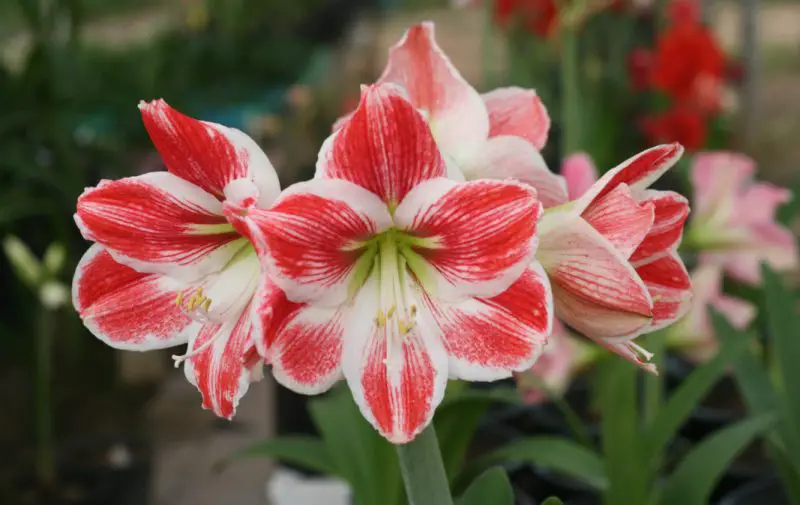Amaryllis plants are famous for their bold, trumpet-shaped flowers that brighten up winter windowsills and garden beds alike. But long after the blooms fade, their strappy green leaves continue to grow—fueling the bulbs for next season’s display. Knowing exactly when to cut these leaves back is the key to healthier bulbs and more impressive blooms next year.
In this guide, you’ll discover the ideal timing and techniques for trimming amaryllis leaves without damaging the plant. Whether you’re growing your bulbs indoors or out in the garden, these expert tips will help you support stronger growth, reduce the risk of disease, and ensure your amaryllis comes back even better the next time it blooms.
Understanding the Lifecycle of Amaryllis

The Growth and Blooming Phases
Amaryllis follows a well-defined seasonal rhythm that gardeners can use to time care practices effectively. After planting or forcing, the bulb enters a period of rapid growth, pushing out tall, hollow flower stalks that may carry multiple blooms. This blooming window typically spans six to ten weeks, with flowers lasting several days to a couple of weeks depending on temperature and light conditions. Once flowering ends, the plant transitions to the vegetative phase, which is just as critical for long-term bulb health.
Understanding this shift from floral display to foliage growth is essential. While the dazzling blooms get most of the attention, it’s what happens after they fade that determines next year’s success. During this time, the plant continues to photosynthesize and build up the bulb’s carbohydrate reserves. Recognizing the signs of this transition ensures that you don’t interrupt the bulb’s natural cycle prematurely.
The Role of Foliage After Blooming
The foliage of amaryllis plays a vital role in strengthening the bulb and preparing it for the next blooming cycle. These long, sword-like green leaves act as solar panels, capturing sunlight and converting it into food stored within the bulb. The more vigorous and long-lived the leaves are, the better the bulb can regenerate and produce even more robust blooms the following season.
Rather than an aesthetic feature, post-bloom foliage serves a deeply functional purpose. Premature removal of the leaves short-circuits this natural process, resulting in weaker bulbs, fewer flowers, or even dormancy failure. To get the most out of each bulb year after year, it’s crucial to allow the foliage to yellow and die back on its own schedule. This natural decline signals that the plant has completed its energy storage, making it the proper time to cut back.
Why Timing Matters When Cutting Amaryllis Leaves
Energy Storage and Future Blooms
In the life cycle of an amaryllis, the post-bloom period is just as critical as the flowering stage. After the brilliant blossoms fade, the leaves take over the essential task of photosynthesis, feeding the bulb with stored sugars and starches that will be used to fuel next season’s growth. This process continues for several months, and cutting back the foliage too early interrupts this energy transfer. The result? A weakened bulb that may either fail to bloom or produce a smaller flower stalk. Healthy, green leaves signal a productive bulb-building period, so allowing them to remain intact until they naturally die back is key for long-term success.
Risks of Cutting Too Early
Removing amaryllis leaves while they’re still green can shock the plant, similar to how pulling a fruit off a tree before it ripens results in lower quality. Premature trimming denies the bulb the nutrients it needs to survive its dormant phase, which could lead to a range of problems—from delayed blooming to total failure in sprouting. In some cases, the bulb may even become vulnerable to fungal diseases or soft rot due to a weakened state. Once the foliage is gone, it’s also harder to gauge the bulb’s health, making it more challenging to correct any care issues before dormancy sets in.
Indicators That It’s Time to Trim
Knowing exactly when to cut back the leaves can make all the difference. Patience is essential, and gardeners should resist the urge to tidy up too soon. Wait until all the foliage has turned yellow or brown and begins to flop over naturally. This discoloration means the photosynthetic activity has ceased, and the plant is preparing for dormancy. At this point, the leaves have already delivered their energy back to the bulb, and cutting them will no longer cause harm. If you notice that some green leaves are still upright while others have browned, wait a bit longer until the entire plant shows uniform signs of decline. Only then should you cut the leaves down to about one to two inches above the bulb for safe removal.
Ideal Timeframes for Cutting Back Amaryllis Leaves
Indoor-Grown Amaryllis
For amaryllis grown indoors in pots, the ideal time to cut back the leaves is about 8 to 10 weeks after the flowers have faded. During this post-bloom period, the long, strap-like leaves play a crucial role by photosynthesizing and sending nutrients back into the bulb, which helps strengthen it for next season’s blooms. It’s essential to allow this process to continue until the foliage starts to yellow and naturally decline.
Avoid the temptation to cut the leaves off while they’re still green, even if they look messy, because doing so can interrupt the plant’s recovery and result in smaller or fewer flowers the following year. Once the leaves turn yellow or brown and flop over, you can use clean, sharp shears to trim them down to about 1–2 inches above the bulb. After cutting back, reduce watering and move the bulb to a cool, dark area if you’re preparing it for dormancy.
Outdoor-Grown Amaryllis
For amaryllis planted outdoors in the ground or in large containers in warm climates (USDA zones 8–11), the timing for cutting back leaves depends more on local weather patterns than a strict schedule. After flowering, the foliage will often remain green and upright for several months, sometimes into late summer or early fall. It’s best to let it grow undisturbed during this time so the bulb can continue to recharge.
Look for natural signs that the plant is entering dormancy—such as yellowing or browning leaves, slowed growth, or cooler nighttime temperatures—before doing any cutting. In most climates, this happens sometime between late summer and early winter. Use clean pruners to cut the leaves back to just above the soil line, but only when they are clearly dying. In regions with mild winters, you may choose not to force dormancy at all, and the plant may stay semi-evergreen. However, trimming back the old foliage still helps tidy the garden and prevents fungal issues or pests from taking hold.
How to Properly Cut Back Amaryllis Leaves
Step-by-Step Cutting Process
Start by identifying leaves that have yellowed or begun to droop, which is a sign that the plant is entering dormancy. Gently grasp each leaf near its base and trim it about one to two inches above the bulb using clean, sharp scissors or shears. Be careful not to tug or pull the leaves, as this could damage the bulb’s neck or disturb the roots. If some green leaves are still firm and upright, wait to cut them until they naturally start to decline—this allows the bulb to absorb more energy for next season’s blooms.
Disinfecting Tools to Prevent Disease
Sterilizing your tools before and after pruning is essential to keep your amaryllis healthy and avoid fungal or bacterial infections. You can use a simple household disinfectant like rubbing alcohol, hydrogen peroxide, or a 1:9 bleach-to-water solution. Dip the blades for at least 30 seconds and wipe them dry before using. This is especially important if you’re trimming multiple plants, as diseases like red blotch or bulb rot can easily spread through contaminated tools.
Post-Trimming Care
Once trimming is complete, reduce watering significantly—just enough to keep the bulb from completely drying out. When the leaves are fully gone and the bulb is dormant, move the pot to a cool, dark location with good airflow, such as a basement or pantry. Avoid locations with high humidity, which can lead to mold. During dormancy (typically 8–10 weeks), refrain from watering and do not fertilize. When you’re ready to restart growth, bring the pot into warmth and bright light, begin watering gradually, and the amaryllis will begin to sprout anew.
Special Considerations Based on Growing Conditions
Tropical and Subtropical Climates
In consistently warm zones such as USDA hardiness zones 9 through 11, amaryllis plants often grow as perennials and may continue producing leaves year-round. Because these bulbs don’t experience a natural dormancy like their temperate counterparts, it’s important to monitor leaf color and condition carefully. Trim only the leaves that are fully yellowed or damaged. Removing healthy green leaves prematurely can deprive the bulb of energy and lead to fewer blooms. In such climates, regular fertilization and watering during the growing season also support leaf health and long-term flowering success.
Cold Climates and Forced Bulbs
In colder regions where amaryllis is typically grown indoors or forced to bloom in winter, managing leaf growth is crucial to bulb recharging. Once flowering ends, allow the leaves to grow and photosynthesize for several months to rebuild energy reserves. Do not cut back green leaves, even if they appear messy. As fall approaches, gradually reduce watering to signal the bulb to enter dormancy. Only cut back the foliage when it turns yellow or brown naturally. Then store the bulb in a cool (around 50–55°F), dry, and dark place for 8 to 12 weeks before starting the next bloom cycle. This rest period is essential for encouraging strong blooms in the next growing season.
Encouraging Dormancy for Healthy Regrowth
Importance of Rest Period
Dormancy is not just a pause—it’s a vital rejuvenation phase that helps the amaryllis bulb restore energy reserves and prepare for a vigorous bloom cycle. Without this period of rest, the bulb may fail to flower or produce weak, underdeveloped blooms in the following season. During dormancy, metabolic processes inside the bulb slow down significantly, allowing it to reset its internal rhythms. This break mirrors the plant’s natural cycle in its native tropical and subtropical climates, where dry seasons force a period of inactivity.
Preparing for Dormancy
To properly induce dormancy, wait until the leaves have naturally yellowed and died back, usually several weeks after the blooming period ends. Then, carefully cut the foliage down to about 1–2 inches above the bulb. Stop watering entirely and withhold any fertilizer. Remove the bulb from the soil if desired, clean off excess dirt, and inspect it for signs of rot or pests. Store the bulb in a dry, well-ventilated area with temperatures consistently between 50°F and 55°F (10°C to 13°C). Place it in peat moss, paper bags, or even netted containers to ensure good airflow. The dormancy should last about 8 to 12 weeks, during which the bulb should remain firm but inactive.
Restarting the Growth Cycle
When the dormancy period ends, it’s time to bring your amaryllis back to life. Begin by examining the bulb to ensure it’s still healthy and firm. Repot it in a well-draining potting mix, leaving about one-third of the bulb exposed above the soil line. Water lightly to avoid rot, and place the pot in a sunny, warm location where daytime temperatures are between 65°F and 75°F (18°C to 24°C). Avoid overwatering during the initial growth phase—wait until new green shoots appear before watering more regularly. Within a few weeks, you should notice new leaf growth, soon followed by the development of a flower stalk, signaling a successful restart of the blooming cycle.
Common Mistakes to Avoid When Cutting Amaryllis Leaves
Cutting Green Leaves Too Early
One of the most frequent mistakes gardeners make is removing green leaves right after the flowers fade. Although the blooming period has ended, the leaves remain essential. They photosynthesize, turning sunlight into energy that is stored in the bulb for next season’s growth. Cutting them prematurely deprives the bulb of this crucial energy source, often resulting in smaller blooms—or no blooms at all—in the following year. Wait until the leaves naturally turn yellow or brown and begin to wither before trimming them off.
Overwatering After Leaf Removal
Another common issue is overwatering after the leaves have been cut. Once the leaves are gone and the bulb enters dormancy, its water needs decrease dramatically. Continuing a regular watering schedule can lead to soggy soil conditions, increasing the risk of fungal rot and bulb decay. After cutting the leaves, it’s best to reduce watering gradually, then stop entirely once the bulb is fully dormant.
Skipping the Dormancy Period
Amaryllis plants benefit greatly from a defined rest period. However, some gardeners—especially those growing amaryllis indoors as houseplants—may skip dormancy altogether. While the plant might continue growing foliage, the lack of a rest cycle weakens the bulb. Over time, this leads to reduced blooming or irregular flower production. For best results, allow the bulb to rest for 8 to 10 weeks in a cool, dry, and dark location before restarting the growth cycle.
Tips for Maximizing Flower Production Year After Year
Fertilizing During Foliage Growth
Feed your amaryllis with a balanced, water-soluble fertilizer—ideally one with equal parts nitrogen, phosphorus, and potassium (such as 10-10-10 or 20-20-20)—every two to four weeks during the foliage phase. Apply the fertilizer after watering to prevent root burn, and continue this routine until the leaves naturally yellow and begin to die back. This steady nutrition during the growth period strengthens the bulb by replenishing energy reserves, which is essential for future flower production. Avoid over-fertilizing, as this can lead to lush leaf growth at the expense of flowers.
Providing Adequate Light
Amaryllis plants thrive on light, especially while building energy through their leaves. Place the plant near a sunny window that gets at least 6 hours of bright, indirect sunlight per day, preferably more. South- or west-facing windows are usually ideal. If grown indoors with limited natural light, consider using a grow light to supplement. Without enough light, the plant will produce weak, floppy leaves that won’t photosynthesize efficiently, resulting in a smaller, weaker bulb and fewer blooms the next season.
Repotting Every Few Years
Over time, amaryllis bulbs can become root-bound or crowded, especially if offsets (baby bulbs) are left growing alongside the parent bulb. This congestion can limit nutrient uptake and bulb expansion, reducing bloom quality and quantity. To maintain vigorous flowering, repot the bulb every two to three years. The best time to do this is in late fall or just before new growth emerges. Choose a pot that is about 1 to 2 inches wider than the bulb, with good drainage, and refresh the soil with a nutrient-rich, well-draining potting mix. When repotting, remove any shriveled roots and separate offsets if you wish to propagate.
When to Expect New Blooms After Cutting Back Leaves
Typical Blooming Timeline
Amaryllis bulbs typically take between 6 to 10 weeks to bloom after coming out of dormancy, but the exact timing can vary depending on growing conditions and bulb health. Warmer indoor temperatures, consistent moisture, and strong indirect sunlight can encourage quicker development. Bulbs forced indoors in late fall can often produce flowers by mid-winter, while those started in early spring may bloom in late spring or early summer. It’s important to note that larger, more mature bulbs often bloom faster and more reliably than smaller or younger ones.
If blooming takes longer than 10 weeks, don’t panic. The bulb may be using extra time to rebuild strength, especially if it didn’t store enough energy during the last growing season. Continue regular watering and ensure the bulb is not exposed to sudden temperature fluctuations, which could delay blooming.
Signs Your Bulb is Ready
The most reliable sign that an amaryllis bulb is preparing to bloom is the emergence of a thick, pointed flower stalk, usually appearing before or alongside any new foliage. This stalk often grows rapidly, sometimes several inches in a few days, and is typically thicker and more upright than a leaf shoot.
If your bulb sends up only leaves without a flower stalk, it may indicate that the bulb is still building up enough stored energy to support blooming. In this case, continue providing bright light and balanced fertilizer, and be patient—some bulbs may take another few weeks to initiate flowering. Another sign of readiness includes a firm, plump bulb with healthy roots and no signs of rot. Bulbs that are soft or shriveled may need more recovery time or a longer dormant phase before blooming again.
FAQs About Cutting Back Amaryllis Leaves
How long does it take for amaryllis to bloom after cutting back the leaves?
It typically takes about 6 to 10 weeks for an amaryllis to bloom after the leaves are cut back and the bulb has gone through proper dormancy. This period allows the bulb to rest, store energy, and prepare for flower development once favorable conditions are restored.
What should I do if only leaves grow back and no flower stalk appears?
If only leaves emerge after dormancy, it could mean the bulb hasn’t stored enough energy to bloom. Make sure the plant receives plenty of bright, indirect sunlight, and feed it with a balanced fertilizer every 2–4 weeks during the growing season. Another dormant period may be needed before the bulb is ready to flower.
Can I force an amaryllis bulb to bloom at a specific time of year?
Yes, you can time dormancy and reactivation to encourage blooming during holidays or special occasions. For example, if you want blooms in December, begin dormancy in late August or early September, then resume watering and light in late October.
How do I know when to restart watering after cutting back the leaves?
Wait until the bulb has rested for about 8 to 10 weeks in a cool, dark place. When you’re ready to wake it up, move it to a bright area and begin watering lightly. Once growth resumes, increase watering and resume normal care.
Should I fertilize the amaryllis right after dormancy?
No, start fertilizing only once you see visible growth such as shoots or a flower stalk. Early fertilization isn’t necessary and could stress the bulb. Use a phosphorus-rich fertilizer to promote flowering once the plant is actively growing.
Conclusion
Knowing exactly when to cut back amaryllis leaves is vital to ensuring that your plant blooms reliably year after year. By observing natural indicators like yellowing leaves, timing your cuts after energy storage is complete, and encouraging proper dormancy, you can enjoy stronger bulbs and more vibrant flowers. Avoid common mistakes, adapt your care to your climate, and you’ll set your amaryllis up for a brilliant floral display season after season.






